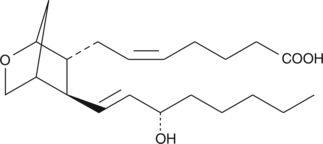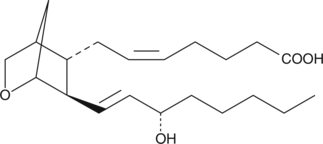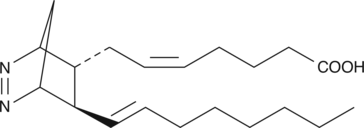Chemicals
Showing 39001–39150 of 41137 results
-
Tyrothricin is a polypeptide antibiotic mixture produced by B. brevis.{38058,38059} Tyrothricin is a mixture of tyrocidine and gramicidin that has rapid in vitro bactericidal activity against T. microdentium, T. macrodentium, T. vincentii, T. buccalis, T. mucosum, T. vaginalis, T. cruzi, and L. tropica.{38059} Preclinical studies demonstrate that intravenous use of tyrothricin leads to hemolysis-induced lethality (LD50s = 0.4 and 0.3 mg/kg, in dogs and mice, respectively) and damages liver, kidney, and olfactory tissues. Formulations containing tyrothricin are used topically to treat bacterial skin infections.{38058,38059}
Brand:CaymanSKU:22177 -Out of stock
TZ9 is a cell-permeable triazine compound that inhibits the human E2 ubiquitin-conjugating enzyme Rad6B.{26248} TZ9 selectively docks to the Rad6B catalytic site, inhibits Rad6B-induced histone H2A ubiquitination, downregulates intracellular β-catenin, induces G2/M arrest and apoptosis, and inhibits proliferation and migration of metastatic human breast cancer cells (IC50 = 6 µM).{26248}
Brand:CaymanSKU:-TZ9 is a cell-permeable triazine compound that inhibits the human E2 ubiquitin-conjugating enzyme Rad6B.{26248} TZ9 selectively docks to the Rad6B catalytic site, inhibits Rad6B-induced histone H2A ubiquitination, downregulates intracellular β-catenin, induces G2/M arrest and apoptosis, and inhibits proliferation and migration of metastatic human breast cancer cells (IC50 = 6 µM).{26248}
Brand:CaymanSKU:-TZ9 is a cell-permeable triazine compound that inhibits the human E2 ubiquitin-conjugating enzyme Rad6B.{26248} TZ9 selectively docks to the Rad6B catalytic site, inhibits Rad6B-induced histone H2A ubiquitination, downregulates intracellular β-catenin, induces G2/M arrest and apoptosis, and inhibits proliferation and migration of metastatic human breast cancer cells (IC50 = 6 µM).{26248}
Brand:CaymanSKU:-U-0126 is a MEK inhibitor with IC50 values of 72 nM and 58 nM for MEK1 and MEK2, respectively.{15076} It is noncompetitive with respect adenosine triphosphate (ATP) and its phosphorylation target ERK and it shows little to no inhibition against a number of other kinases including PKC, Ab1, Raf, MEKK, ERK, JNK, MKK-3, MKK-4, MKK-6, Cdk2, and Cdk4. However, U-0126 does phosphorylate and activate AMP-activated protein kinase (AMPK) in a dose-dependent manner (EC50 = 15 µM in HEK293 cells).{42109} It increases the ratios of ADP to ATP and AMP to ATP and increases phosphorylation of the AMPK target acetyl-CoA carboxylase (ACC).
Brand:CaymanSKU:70970 - 1 mgAvailable on backorder
U-0126 is a MEK inhibitor with IC50 values of 72 nM and 58 nM for MEK1 and MEK2, respectively.{15076} It is noncompetitive with respect adenosine triphosphate (ATP) and its phosphorylation target ERK and it shows little to no inhibition against a number of other kinases including PKC, Ab1, Raf, MEKK, ERK, JNK, MKK-3, MKK-4, MKK-6, Cdk2, and Cdk4. However, U-0126 does phosphorylate and activate AMP-activated protein kinase (AMPK) in a dose-dependent manner (EC50 = 15 µM in HEK293 cells).{42109} It increases the ratios of ADP to ATP and AMP to ATP and increases phosphorylation of the AMPK target acetyl-CoA carboxylase (ACC).
Brand:CaymanSKU:70970 - 10 mgAvailable on backorder
U-0126 is a MEK inhibitor with IC50 values of 72 nM and 58 nM for MEK1 and MEK2, respectively.{15076} It is noncompetitive with respect adenosine triphosphate (ATP) and its phosphorylation target ERK and it shows little to no inhibition against a number of other kinases including PKC, Ab1, Raf, MEKK, ERK, JNK, MKK-3, MKK-4, MKK-6, Cdk2, and Cdk4. However, U-0126 does phosphorylate and activate AMP-activated protein kinase (AMPK) in a dose-dependent manner (EC50 = 15 µM in HEK293 cells).{42109} It increases the ratios of ADP to ATP and AMP to ATP and increases phosphorylation of the AMPK target acetyl-CoA carboxylase (ACC).
Brand:CaymanSKU:70970 - 25 mgAvailable on backorder
U-0126 is a MEK inhibitor with IC50 values of 72 nM and 58 nM for MEK1 and MEK2, respectively.{15076} It is noncompetitive with respect adenosine triphosphate (ATP) and its phosphorylation target ERK and it shows little to no inhibition against a number of other kinases including PKC, Ab1, Raf, MEKK, ERK, JNK, MKK-3, MKK-4, MKK-6, Cdk2, and Cdk4. However, U-0126 does phosphorylate and activate AMP-activated protein kinase (AMPK) in a dose-dependent manner (EC50 = 15 µM in HEK293 cells).{42109} It increases the ratios of ADP to ATP and AMP to ATP and increases phosphorylation of the AMPK target acetyl-CoA carboxylase (ACC).
Brand:CaymanSKU:70970 - 5 mgAvailable on backorder
Impaired trafficking of cholesterol to or from the endoplasmic reticulum (ER) has been implicated in many disease states including Neimann-Pick disease type C (NPC), Alzheimers disease and atherosclerosis. U-18666A is a cell permeable drug that inhibits cholesterol trafficking. It inhibits cholesterol transport from late endosomes/lysosomes to the endoplasmic reticulum (ER), but not cholesterol transport to the plasma membrane as demonstrated in many cell types including macrophages, primary cortical neurons and primary fibroblasts.{14577,14579,14578} In macrophages, micromolar concentrations of U-18666A inhibit multiple pathways of cholesterol trafficking from late endosomes, whereas nanomolar concentrations impair cholesterol trafficking to the ER, a response similar to that found in NPC. U-18666A inhibits oxidosqualene cyclase at high (>0.5 mM) concentrations and oral doses (10 mg/kg) induces cataracts in rats.{14577}
Brand:CaymanSKU:10009085 - 10 mgAvailable on backorder
Impaired trafficking of cholesterol to or from the endoplasmic reticulum (ER) has been implicated in many disease states including Neimann-Pick disease type C (NPC), Alzheimers disease and atherosclerosis. U-18666A is a cell permeable drug that inhibits cholesterol trafficking. It inhibits cholesterol transport from late endosomes/lysosomes to the endoplasmic reticulum (ER), but not cholesterol transport to the plasma membrane as demonstrated in many cell types including macrophages, primary cortical neurons and primary fibroblasts.{14577,14579,14578} In macrophages, micromolar concentrations of U-18666A inhibit multiple pathways of cholesterol trafficking from late endosomes, whereas nanomolar concentrations impair cholesterol trafficking to the ER, a response similar to that found in NPC. U-18666A inhibits oxidosqualene cyclase at high (>0.5 mM) concentrations and oral doses (10 mg/kg) induces cataracts in rats.{14577}
Brand:CaymanSKU:10009085 - 25 mgAvailable on backorder
Impaired trafficking of cholesterol to or from the endoplasmic reticulum (ER) has been implicated in many disease states including Neimann-Pick disease type C (NPC), Alzheimers disease and atherosclerosis. U-18666A is a cell permeable drug that inhibits cholesterol trafficking. It inhibits cholesterol transport from late endosomes/lysosomes to the endoplasmic reticulum (ER), but not cholesterol transport to the plasma membrane as demonstrated in many cell types including macrophages, primary cortical neurons and primary fibroblasts.{14577,14579,14578} In macrophages, micromolar concentrations of U-18666A inhibit multiple pathways of cholesterol trafficking from late endosomes, whereas nanomolar concentrations impair cholesterol trafficking to the ER, a response similar to that found in NPC. U-18666A inhibits oxidosqualene cyclase at high (>0.5 mM) concentrations and oral doses (10 mg/kg) induces cataracts in rats.{14577}
Brand:CaymanSKU:10009085 - 5 mgAvailable on backorder
Impaired trafficking of cholesterol to or from the endoplasmic reticulum (ER) has been implicated in many disease states including Neimann-Pick disease type C (NPC), Alzheimers disease and atherosclerosis. U-18666A is a cell permeable drug that inhibits cholesterol trafficking. It inhibits cholesterol transport from late endosomes/lysosomes to the endoplasmic reticulum (ER), but not cholesterol transport to the plasma membrane as demonstrated in many cell types including macrophages, primary cortical neurons and primary fibroblasts.{14577,14579,14578} In macrophages, micromolar concentrations of U-18666A inhibit multiple pathways of cholesterol trafficking from late endosomes, whereas nanomolar concentrations impair cholesterol trafficking to the ER, a response similar to that found in NPC. U-18666A inhibits oxidosqualene cyclase at high (>0.5 mM) concentrations and oral doses (10 mg/kg) induces cataracts in rats.{14577}
Brand:CaymanSKU:10009085 - 50 mgAvailable on backorder
U-44069 is a stable analog of the endoperoxide PGH2 (Item No. 17020) and a TP receptor agonist. It stimulates shape change in human platelets without a measurable increase in [Ca2+] with an EC50 value of 1.8 nM.{485} U-44069 has an EC50 value of 3 µM and 54 nM for platelet aggregation and phosphatidate formation in human platelets, respectively.{713}
Brand:CaymanSKU:-Out of stock
U-44069 is a stable analog of the endoperoxide PGH2 (Item No. 17020) and a TP receptor agonist. It stimulates shape change in human platelets without a measurable increase in [Ca2+] with an EC50 value of 1.8 nM.{485} U-44069 has an EC50 value of 3 µM and 54 nM for platelet aggregation and phosphatidate formation in human platelets, respectively.{713}
Brand:CaymanSKU:-Out of stock
U-44069 is a stable analog of the endoperoxide PGH2 (Item No. 17020) and a TP receptor agonist. It stimulates shape change in human platelets without a measurable increase in [Ca2+] with an EC50 value of 1.8 nM.{485} U-44069 has an EC50 value of 3 µM and 54 nM for platelet aggregation and phosphatidate formation in human platelets, respectively.{713}
Brand:CaymanSKU:-Out of stock
U-46619 is a stable analog of the endoperoxide prostaglandin H2, and a TP receptor agonist.{8322} It exhibits properties similar to thromboxane A2, causing platelet shape change and aggregation, and contraction of vascular smooth muscle.{490,714} Mean EC50 values for shape change in human, rat, and rabbit platelets are 4.8, 6.0, and 7.3 nM respectively, and for aggregation are 82, 145, and 65 nM, respectively.{1168}
Brand:CaymanSKU:-Out of stock
U-46619 is a stable analog of the endoperoxide prostaglandin H2, and a TP receptor agonist.{8322} It exhibits properties similar to thromboxane A2, causing platelet shape change and aggregation, and contraction of vascular smooth muscle.{490,714} Mean EC50 values for shape change in human, rat, and rabbit platelets are 4.8, 6.0, and 7.3 nM respectively, and for aggregation are 82, 145, and 65 nM, respectively.{1168}
Brand:CaymanSKU:-Out of stock
U-46619 is a stable analog of the endoperoxide prostaglandin H2, and a TP receptor agonist.{8322} It exhibits properties similar to thromboxane A2, causing platelet shape change and aggregation, and contraction of vascular smooth muscle.{490,714} Mean EC50 values for shape change in human, rat, and rabbit platelets are 4.8, 6.0, and 7.3 nM respectively, and for aggregation are 82, 145, and 65 nM, respectively.{1168}
Brand:CaymanSKU:-Out of stock
U-47109 (Item No. 21663) is an analytical reference standard categorized as an opioid.{43743,43744} This product is intended for research and forensic applications.
Brand:CaymanSKU:21663 -Out of stock
U-47109 (Item No. 21663) is an analytical reference standard categorized as an opioid.{43743,43744} This product is intended for research and forensic applications.
Brand:CaymanSKU:21663 -Out of stock
U-47931E (Item No. 20530) is an analytical reference standard that is structurally categorized as an opioid. It has been characterized as a selective µ-opioid receptor agonist, based on the ability of the antagonist β-funaltrexamine to block U-47931E-mediated decrease in urine output in water-loaded rats.{32325} U-47931E has antinociceptive activity comparable to codeine (Item No. ISO60140) in mouse abdominal constriction and rat paw pressure tests.{32324} This product is intended for research and forensic applications.
Brand:CaymanSKU:20530 -Available on backorder
U-47931E (Item No. 20530) is an analytical reference standard that is structurally categorized as an opioid. It has been characterized as a selective µ-opioid receptor agonist, based on the ability of the antagonist β-funaltrexamine to block U-47931E-mediated decrease in urine output in water-loaded rats.{32325} U-47931E has antinociceptive activity comparable to codeine (Item No. ISO60140) in mouse abdominal constriction and rat paw pressure tests.{32324} This product is intended for research and forensic applications.
Brand:CaymanSKU:20530 -Available on backorder
U-48520 (Item No. 26274) is an analytical reference standard that is structurally similar to known opioids. This product is intended for research and forensic applications.
Brand:CaymanSKU:26274 - 1 mgAvailable on backorder
U-48520 (Item No. 26274) is an analytical reference standard that is structurally similar to known opioids. This product is intended for research and forensic applications.
Brand:CaymanSKU:26274 - 5 mgAvailable on backorder
U-48753E (maleate) (Item No. 20734) is an analytical reference standard that is functionally categorized as a nontricyclic antidepressant. It has been shown to modulate signaling through yohimbine (Item No. 19869), oxotremorine, and apomorphine in mice, although its physiological and toxicological effects in humans are not known.{32767} This product is intended for research and forensic applications.
Brand:CaymanSKU:20734 -Available on backorder
U-48753E (maleate) (Item No. 20734) is an analytical reference standard that is functionally categorized as a nontricyclic antidepressant. It has been shown to modulate signaling through yohimbine (Item No. 19869), oxotremorine, and apomorphine in mice, although its physiological and toxicological effects in humans are not known.{32767} This product is intended for research and forensic applications.
Brand:CaymanSKU:20734 -Available on backorder
U-51605 is a stable analog of the endoperoxide prostaglandin H2 (PGH2). It is an inhibitor of both prostacyclin (PGI) and thromboxane (TX) synthases with more selectivity towards PGI synthase. U-51605 is also a partial agonist at TP receptors.{817} In human foreskin fibroblasts, U-51605 inhibits PGI synthase at a concentration of 2.8 µM, whereas, human platelet TX synthase is inhibited at a concentration of 5.6 µM.{818,486} At concentrations up to 1 µM, U-51605 reduced the release of prostacyclin in SHR aorta elicited by the calcium ionophore A-23187 with no effect on TXA2 production and yet significantly increased PGE2 and PGF2α release.{18479}
Brand:CaymanSKU:-Out of stock
U-51605 is a stable analog of the endoperoxide prostaglandin H2 (PGH2). It is an inhibitor of both prostacyclin (PGI) and thromboxane (TX) synthases with more selectivity towards PGI synthase. U-51605 is also a partial agonist at TP receptors.{817} In human foreskin fibroblasts, U-51605 inhibits PGI synthase at a concentration of 2.8 µM, whereas, human platelet TX synthase is inhibited at a concentration of 5.6 µM.{818,486} At concentrations up to 1 µM, U-51605 reduced the release of prostacyclin in SHR aorta elicited by the calcium ionophore A-23187 with no effect on TXA2 production and yet significantly increased PGE2 and PGF2α release.{18479}
Brand:CaymanSKU:-Out of stock
U-51605 is a stable analog of the endoperoxide prostaglandin H2 (PGH2). It is an inhibitor of both prostacyclin (PGI) and thromboxane (TX) synthases with more selectivity towards PGI synthase. U-51605 is also a partial agonist at TP receptors.{817} In human foreskin fibroblasts, U-51605 inhibits PGI synthase at a concentration of 2.8 µM, whereas, human platelet TX synthase is inhibited at a concentration of 5.6 µM.{818,486} At concentrations up to 1 µM, U-51605 reduced the release of prostacyclin in SHR aorta elicited by the calcium ionophore A-23187 with no effect on TXA2 production and yet significantly increased PGE2 and PGF2α release.{18479}
Brand:CaymanSKU:-Out of stock
U-51605 is a stable analog of the endoperoxide prostaglandin H2 (PGH2). It is an inhibitor of both prostacyclin (PGI) and thromboxane (TX) synthases with more selectivity towards PGI synthase. U-51605 is also a partial agonist at TP receptors.{817} In human foreskin fibroblasts, U-51605 inhibits PGI synthase at a concentration of 2.8 µM, whereas, human platelet TX synthase is inhibited at a concentration of 5.6 µM.{818,486} At concentrations up to 1 µM, U-51605 reduced the release of prostacyclin in SHR aorta elicited by the calcium ionophore A-23187 with no effect on TXA2 production and yet significantly increased PGE2 and PGF2α release.{18479}
Brand:CaymanSKU:-Out of stock
U-62066 (mesylate) (Item No. 25072) is an analytical reference standard categorized as an opioid.{36805} This product is intended for research and forensic applications.
Brand:CaymanSKU:25072 - 1 mgAvailable on backorder
U-62066 (mesylate) (Item No. 25072) is an analytical reference standard categorized as an opioid.{36805} This product is intended for research and forensic applications.
Brand:CaymanSKU:25072 - 5 mgAvailable on backorder
U-73122 is an inhibitor of PLC-dependent processes, however, the mechanism of action remains unclear.{5296,3187,6007} The IC50 values for inhibition of platelet aggregation induced by collagen or thrombin are 0.6 and 5 µM, respectively.{3187} It also exhibits inhibitory activity against HIV-1 integrase with an IC50 value of 7 µM.{3607}
Brand:CaymanSKU:70740 - 1 mgAvailable on backorder
U-73122 is an inhibitor of PLC-dependent processes, however, the mechanism of action remains unclear.{5296,3187,6007} The IC50 values for inhibition of platelet aggregation induced by collagen or thrombin are 0.6 and 5 µM, respectively.{3187} It also exhibits inhibitory activity against HIV-1 integrase with an IC50 value of 7 µM.{3607}
Brand:CaymanSKU:70740 - 10 mgAvailable on backorder
U-73122 is an inhibitor of PLC-dependent processes, however, the mechanism of action remains unclear.{5296,3187,6007} The IC50 values for inhibition of platelet aggregation induced by collagen or thrombin are 0.6 and 5 µM, respectively.{3187} It also exhibits inhibitory activity against HIV-1 integrase with an IC50 value of 7 µM.{3607}
Brand:CaymanSKU:70740 - 25 mgAvailable on backorder
U-73122 is an inhibitor of PLC-dependent processes, however, the mechanism of action remains unclear.{5296,3187,6007} The IC50 values for inhibition of platelet aggregation induced by collagen or thrombin are 0.6 and 5 µM, respectively.{3187} It also exhibits inhibitory activity against HIV-1 integrase with an IC50 value of 7 µM.{3607}
Brand:CaymanSKU:70740 - 5 mgAvailable on backorder
U-73122 (Item No. 70740) is an inhibitor of PLC-dependent processes, however, the mechanism of action remains unclear.{5296,3187,6007} The IC50 values for inhibition of platelet aggregation induced by collagen or thrombin are 0.6 and 5 µM, respectively.{3187} It also exhibits inhibitory activity against HIV-1 integrase with an IC50 value of 7 µM.{3607} U-73343 is a close structural analog of U-73122 that does not inhibit PLC, making it useful as a negative control for PLC inhibition.{5296}
Brand:CaymanSKU:-Available on backorder
U-73122 (Item No. 70740) is an inhibitor of PLC-dependent processes, however, the mechanism of action remains unclear.{5296,3187,6007} The IC50 values for inhibition of platelet aggregation induced by collagen or thrombin are 0.6 and 5 µM, respectively.{3187} It also exhibits inhibitory activity against HIV-1 integrase with an IC50 value of 7 µM.{3607} U-73343 is a close structural analog of U-73122 that does not inhibit PLC, making it useful as a negative control for PLC inhibition.{5296}
Brand:CaymanSKU:-Available on backorder
U-73122 (Item No. 70740) is an inhibitor of PLC-dependent processes, however, the mechanism of action remains unclear.{5296,3187,6007} The IC50 values for inhibition of platelet aggregation induced by collagen or thrombin are 0.6 and 5 µM, respectively.{3187} It also exhibits inhibitory activity against HIV-1 integrase with an IC50 value of 7 µM.{3607} U-73343 is a close structural analog of U-73122 that does not inhibit PLC, making it useful as a negative control for PLC inhibition.{5296}
Brand:CaymanSKU:-Available on backorder
U-73122 (Item No. 70740) is an inhibitor of PLC-dependent processes, however, the mechanism of action remains unclear.{5296,3187,6007} The IC50 values for inhibition of platelet aggregation induced by collagen or thrombin are 0.6 and 5 µM, respectively.{3187} It also exhibits inhibitory activity against HIV-1 integrase with an IC50 value of 7 µM.{3607} U-73343 is a close structural analog of U-73122 that does not inhibit PLC, making it useful as a negative control for PLC inhibition.{5296}
Brand:CaymanSKU:-Available on backorder
U-74389G is an antioxidant which prevents iron-dependent lipid peroxidation. It protects against ischemia-reperfusion injury in animal heart, liver, and kidney models.{4561,4612,4562,4567}
Brand:CaymanSKU:75860 - 100 mgAvailable on backorder
U-74389G is an antioxidant which prevents iron-dependent lipid peroxidation. It protects against ischemia-reperfusion injury in animal heart, liver, and kidney models.{4561,4612,4562,4567}
Brand:CaymanSKU:75860 - 250 mgAvailable on backorder
U-74389G is an antioxidant which prevents iron-dependent lipid peroxidation. It protects against ischemia-reperfusion injury in animal heart, liver, and kidney models.{4561,4612,4562,4567}
Brand:CaymanSKU:75860 - 50 mgAvailable on backorder
U-75302 is an LTB4 receptor antagonist with a Ki of 159 nM on guinea pig lung membranes.{1106,4341} This activity is specific for the BLT1 receptor; U-75302 does not antagonize the binding of [3H]-LTB4 to the human BLT2 receptor.{8743}
Brand:CaymanSKU:70705 - 1 mgAvailable on backorder
U-75302 is an LTB4 receptor antagonist with a Ki of 159 nM on guinea pig lung membranes.{1106,4341} This activity is specific for the BLT1 receptor; U-75302 does not antagonize the binding of [3H]-LTB4 to the human BLT2 receptor.{8743}
Brand:CaymanSKU:70705 - 100 µgAvailable on backorder
U-75302 is an LTB4 receptor antagonist with a Ki of 159 nM on guinea pig lung membranes.{1106,4341} This activity is specific for the BLT1 receptor; U-75302 does not antagonize the binding of [3H]-LTB4 to the human BLT2 receptor.{8743}
Brand:CaymanSKU:70705 - 50 µgAvailable on backorder
U-75302 is an LTB4 receptor antagonist with a Ki of 159 nM on guinea pig lung membranes.{1106,4341} This activity is specific for the BLT1 receptor; U-75302 does not antagonize the binding of [3H]-LTB4 to the human BLT2 receptor.{8743}
Brand:CaymanSKU:70705 - 500 µgAvailable on backorder
U-92016A is an agonist of the serotonin (5-HT) receptor subtype 5-HT1A (Ki = 0.4 nM).{39641} It is selective for 5-HT1A over 5-HT1D, 5-HT2, dopamine D1 and D2, and α1- and α2-adrenergic receptors (Kis = 7.7, >1,000, >1,000, 36, >1,000, and >1,000 nM, respectively). U-92016A inhibits forskolin-stimulated cAMP synthesis in CHO cells transfected with human 5-HT1A. In vivo, U-92016A induces hypothermia in mice (ED50 = 0.041 mg/kg). It induces 5-HT syndrome, as measured by increased flat body posture and reciprocal forepaw treading, as well as decreases accumulation of 5-HT and dopamine in rats when administered at a dose of 5 mg/kg. U-92016A also decreases arterial blood pressure and heart rate in a dose-dependent manner in spontaneously hypertensive rats and reverses isolation-induced aggression in mice.
Brand:CaymanSKU:23807 - 1 mgAvailable on backorder
U-92016A is an agonist of the serotonin (5-HT) receptor subtype 5-HT1A (Ki = 0.4 nM).{39641} It is selective for 5-HT1A over 5-HT1D, 5-HT2, dopamine D1 and D2, and α1- and α2-adrenergic receptors (Kis = 7.7, >1,000, >1,000, 36, >1,000, and >1,000 nM, respectively). U-92016A inhibits forskolin-stimulated cAMP synthesis in CHO cells transfected with human 5-HT1A. In vivo, U-92016A induces hypothermia in mice (ED50 = 0.041 mg/kg). It induces 5-HT syndrome, as measured by increased flat body posture and reciprocal forepaw treading, as well as decreases accumulation of 5-HT and dopamine in rats when administered at a dose of 5 mg/kg. U-92016A also decreases arterial blood pressure and heart rate in a dose-dependent manner in spontaneously hypertensive rats and reverses isolation-induced aggression in mice.
Brand:CaymanSKU:23807 - 10 mgAvailable on backorder
U-92016A is an agonist of the serotonin (5-HT) receptor subtype 5-HT1A (Ki = 0.4 nM).{39641} It is selective for 5-HT1A over 5-HT1D, 5-HT2, dopamine D1 and D2, and α1- and α2-adrenergic receptors (Kis = 7.7, >1,000, >1,000, 36, >1,000, and >1,000 nM, respectively). U-92016A inhibits forskolin-stimulated cAMP synthesis in CHO cells transfected with human 5-HT1A. In vivo, U-92016A induces hypothermia in mice (ED50 = 0.041 mg/kg). It induces 5-HT syndrome, as measured by increased flat body posture and reciprocal forepaw treading, as well as decreases accumulation of 5-HT and dopamine in rats when administered at a dose of 5 mg/kg. U-92016A also decreases arterial blood pressure and heart rate in a dose-dependent manner in spontaneously hypertensive rats and reverses isolation-induced aggression in mice.
Brand:CaymanSKU:23807 - 5 mgAvailable on backorder
U-93631 is a GABAA receptor ligand.{47207} It accelerates decay of GABA-induced currents in HEK293 cells expressing rat α1β2, β2γ2, and α1γ2 subunit-containing GABAA receptors when used at a concentration of 5 μM. U-93631 inhibits radioligand binding to the picrotoxin site on α1β2γ2 subunit-containing GABAA receptors.{47208}
Brand:CaymanSKU:26417 - 10 mgAvailable on backorder
U-93631 is a GABAA receptor ligand.{47207} It accelerates decay of GABA-induced currents in HEK293 cells expressing rat α1β2, β2γ2, and α1γ2 subunit-containing GABAA receptors when used at a concentration of 5 μM. U-93631 inhibits radioligand binding to the picrotoxin site on α1β2γ2 subunit-containing GABAA receptors.{47208}
Brand:CaymanSKU:26417 - 100 mgAvailable on backorder
U-93631 is a GABAA receptor ligand.{47207} It accelerates decay of GABA-induced currents in HEK293 cells expressing rat α1β2, β2γ2, and α1γ2 subunit-containing GABAA receptors when used at a concentration of 5 μM. U-93631 inhibits radioligand binding to the picrotoxin site on α1β2γ2 subunit-containing GABAA receptors.{47208}
Brand:CaymanSKU:26417 - 25 mgAvailable on backorder
U-93631 is a GABAA receptor ligand.{47207} It accelerates decay of GABA-induced currents in HEK293 cells expressing rat α1β2, β2γ2, and α1γ2 subunit-containing GABAA receptors when used at a concentration of 5 μM. U-93631 inhibits radioligand binding to the picrotoxin site on α1β2γ2 subunit-containing GABAA receptors.{47208}
Brand:CaymanSKU:26417 - 50 mgAvailable on backorder
UAMC 0039 is a potent inhibitor of dipeptidyl peptidase 2 (DPP-2; IC50 = 0.48 nM).{34797} It also inhibits DPP-4 (IC50 = 165 µM). DPP-2 is thought to be involved in degradation of collagen, substance P, and some proline-containing neuropeptides.{34797,34798,34799}
Brand:CaymanSKU:-UAMC 0039 is a potent inhibitor of dipeptidyl peptidase 2 (DPP-2; IC50 = 0.48 nM).{34797} It also inhibits DPP-4 (IC50 = 165 µM). DPP-2 is thought to be involved in degradation of collagen, substance P, and some proline-containing neuropeptides.{34797,34798,34799}
Brand:CaymanSKU:-UAMC 0039 is a potent inhibitor of dipeptidyl peptidase 2 (DPP-2; IC50 = 0.48 nM).{34797} It also inhibits DPP-4 (IC50 = 165 µM). DPP-2 is thought to be involved in degradation of collagen, substance P, and some proline-containing neuropeptides.{34797,34798,34799}
Brand:CaymanSKU:-UAMC-3203 is an inhibitor of ferroptosis that has an IC50 value of 10 nM for inhibition of erastin-induced ferroptosis in IMR-32 neuroblastoma cells.{47300} It decreases iron-induced plasma lactate dehydrogenase (LDH) levels in a mouse model of acute iron poisoning when administered at a dose of 20 µmol/kg. It is not toxic to mice following chronic administration of a 20 µmol/kg dose for four weeks. UAMC-3203 has increased solubility and a longer half-life in mouse, rat, and human microsomes and isolated plasma than the ferroptosis inhibitor ferrostatin-1 (Item No. 17729). In an in silico membrane dynamics study, UAMC-3203 was incorporated into a phospholipid bilayer.
Brand:CaymanSKU:26525 - 1 mgAvailable on backorder
UAMC-3203 is an inhibitor of ferroptosis that has an IC50 value of 10 nM for inhibition of erastin-induced ferroptosis in IMR-32 neuroblastoma cells.{47300} It decreases iron-induced plasma lactate dehydrogenase (LDH) levels in a mouse model of acute iron poisoning when administered at a dose of 20 µmol/kg. It is not toxic to mice following chronic administration of a 20 µmol/kg dose for four weeks. UAMC-3203 has increased solubility and a longer half-life in mouse, rat, and human microsomes and isolated plasma than the ferroptosis inhibitor ferrostatin-1 (Item No. 17729). In an in silico membrane dynamics study, UAMC-3203 was incorporated into a phospholipid bilayer.
Brand:CaymanSKU:26525 - 5 mgAvailable on backorder
UAMC-3203 is an inhibitor of ferroptosis that has an IC50 value of 10 nM for inhibition of erastin-induced ferroptosis in IMR-32 neuroblastoma cells.{47300} It decreases iron-induced plasma lactate dehydrogenase (LDH) levels in a mouse model of acute iron poisoning when administered at a dose of 20 µmol/kg. It is not toxic to mice following chronic administration of a 20 µmol/kg dose for four weeks. UAMC-3203 has increased solubility and a longer half-life in mouse, rat, and human microsomes and isolated plasma than the ferroptosis inhibitor ferrostatin-1 (Item No. 17729). In an in silico membrane dynamics study, UAMC-3203 was incorporated into a phospholipid bilayer.
Brand:CaymanSKU:26525 - 500 µgAvailable on backorder
UAMC-3203 is an inhibitor of ferroptosis that has an IC50 value of 10 nM for inhibition of erastin-induced ferroptosis in IMR-32 neuroblastoma cells.{47300} It decreases iron-induced plasma lactate dehydrogenase (LDH) levels in a mouse model of acute iron poisoning when administered at a dose of 20 µmol/kg. It is not toxic to mice following chronic administration of a 20 µmol/kg dose for four weeks. UAMC-3203 has increased solubility and a longer half-life in mouse, rat, and human microsomes and isolated plasma than the ferroptosis inhibitor ferrostatin-1 (Item No. 17729). In an in silico membrane dynamics study, UAMC-3203 was incorporated into a phospholipid bilayer.
Brand:CaymanSKU:29346 - 1 mgAvailable on backorder
UAMC-3203 is an inhibitor of ferroptosis that has an IC50 value of 10 nM for inhibition of erastin-induced ferroptosis in IMR-32 neuroblastoma cells.{47300} It decreases iron-induced plasma lactate dehydrogenase (LDH) levels in a mouse model of acute iron poisoning when administered at a dose of 20 µmol/kg. It is not toxic to mice following chronic administration of a 20 µmol/kg dose for four weeks. UAMC-3203 has increased solubility and a longer half-life in mouse, rat, and human microsomes and isolated plasma than the ferroptosis inhibitor ferrostatin-1 (Item No. 17729). In an in silico membrane dynamics study, UAMC-3203 was incorporated into a phospholipid bilayer.
Brand:CaymanSKU:29346 - 10 mgAvailable on backorder
UAMC-3203 is an inhibitor of ferroptosis that has an IC50 value of 10 nM for inhibition of erastin-induced ferroptosis in IMR-32 neuroblastoma cells.{47300} It decreases iron-induced plasma lactate dehydrogenase (LDH) levels in a mouse model of acute iron poisoning when administered at a dose of 20 µmol/kg. It is not toxic to mice following chronic administration of a 20 µmol/kg dose for four weeks. UAMC-3203 has increased solubility and a longer half-life in mouse, rat, and human microsomes and isolated plasma than the ferroptosis inhibitor ferrostatin-1 (Item No. 17729). In an in silico membrane dynamics study, UAMC-3203 was incorporated into a phospholipid bilayer.
Brand:CaymanSKU:29346 - 25 mgAvailable on backorder
UAMC-3203 is an inhibitor of ferroptosis that has an IC50 value of 10 nM for inhibition of erastin-induced ferroptosis in IMR-32 neuroblastoma cells.{47300} It decreases iron-induced plasma lactate dehydrogenase (LDH) levels in a mouse model of acute iron poisoning when administered at a dose of 20 µmol/kg. It is not toxic to mice following chronic administration of a 20 µmol/kg dose for four weeks. UAMC-3203 has increased solubility and a longer half-life in mouse, rat, and human microsomes and isolated plasma than the ferroptosis inhibitor ferrostatin-1 (Item No. 17729). In an in silico membrane dynamics study, UAMC-3203 was incorporated into a phospholipid bilayer.
Brand:CaymanSKU:29346 - 5 mgAvailable on backorder
Ubiquinol is a reduced form of coenzyme Q10 (Item No. 11506). Coenzyme Q10 exists in three redox states: fully oxidized (ubiquinone), partially reduced (semiquinone or ubisemiquinone), and fully reduced (ubiquinol).{20672,20670} The redox functions of ubiquinol in cellular energy production and antioxidant protection are based on the exchange of two electrons in a redox cycle between ubiquinol (reduced) and the ubiquinone (oxidized) form.{20672,20670,2600} The reduction of ubiquinone to ubiquinol occurs in Complexes I & II in the electron transport chain.{20670}
Brand:CaymanSKU:19677 -Available on backorder
Ubiquinol is a reduced form of coenzyme Q10 (Item No. 11506). Coenzyme Q10 exists in three redox states: fully oxidized (ubiquinone), partially reduced (semiquinone or ubisemiquinone), and fully reduced (ubiquinol).{20672,20670} The redox functions of ubiquinol in cellular energy production and antioxidant protection are based on the exchange of two electrons in a redox cycle between ubiquinol (reduced) and the ubiquinone (oxidized) form.{20672,20670,2600} The reduction of ubiquinone to ubiquinol occurs in Complexes I & II in the electron transport chain.{20670}
Brand:CaymanSKU:19677 -Available on backorder
Ubiquinol is a reduced form of coenzyme Q10 (Item No. 11506). Coenzyme Q10 exists in three redox states: fully oxidized (ubiquinone), partially reduced (semiquinone or ubisemiquinone), and fully reduced (ubiquinol).{20672,20670} The redox functions of ubiquinol in cellular energy production and antioxidant protection are based on the exchange of two electrons in a redox cycle between ubiquinol (reduced) and the ubiquinone (oxidized) form.{20672,20670,2600} The reduction of ubiquinone to ubiquinol occurs in Complexes I & II in the electron transport chain.{20670}
Brand:CaymanSKU:19677 -Available on backorder
Ubiquinol is a reduced form of coenzyme Q10 (Item No. 11506). Coenzyme Q10 exists in three redox states: fully oxidized (ubiquinone), partially reduced (semiquinone or ubisemiquinone), and fully reduced (ubiquinol).{20672,20670} The redox functions of ubiquinol in cellular energy production and antioxidant protection are based on the exchange of two electrons in a redox cycle between ubiquinol (reduced) and the ubiquinone (oxidized) form.{20672,20670,2600} The reduction of ubiquinone to ubiquinol occurs in Complexes I & II in the electron transport chain.{20670}
Brand:CaymanSKU:19677 -Available on backorder
Ubiquitin isopeptidase inhibitor I induces caspase activation and apoptosis (IC50 = ~1.7 µM) through a Bcl-2-dependent and apoptosome-independent mitochondrial pathway that selectively inhibits ubiquitin isopeptidase activity (IC50 = ~30 µM).{27605} It has also been shown to induce necrosis in apoptosis-resistant DKO cells.{32895}
Brand:CaymanSKU:21006 -Out of stock
Ubiquitin isopeptidase inhibitor I induces caspase activation and apoptosis (IC50 = ~1.7 µM) through a Bcl-2-dependent and apoptosome-independent mitochondrial pathway that selectively inhibits ubiquitin isopeptidase activity (IC50 = ~30 µM).{27605} It has also been shown to induce necrosis in apoptosis-resistant DKO cells.{32895}
Brand:CaymanSKU:21006 -Out of stock
Ubiquitin isopeptidase inhibitor I induces caspase activation and apoptosis (IC50 = ~1.7 µM) through a Bcl-2-dependent and apoptosome-independent mitochondrial pathway that selectively inhibits ubiquitin isopeptidase activity (IC50 = ~30 µM).{27605} It has also been shown to induce necrosis in apoptosis-resistant DKO cells.{32895}
Brand:CaymanSKU:21006 -Out of stock
UBP 301 is an antagonist of the kainate receptor, an ionotropic glutamate receptor (apparent Kd = 5.94 µM).{28499} It displays ~30-fold selectivity over AMPA receptors.{28499} UBP 301 is used to assess the roles of kainate receptors in neuronal signaling, particularly in reference to neuropathic pain.{28501,28500}
Brand:CaymanSKU:-Available on backorder
UBP 301 is an antagonist of the kainate receptor, an ionotropic glutamate receptor (apparent Kd = 5.94 µM).{28499} It displays ~30-fold selectivity over AMPA receptors.{28499} UBP 301 is used to assess the roles of kainate receptors in neuronal signaling, particularly in reference to neuropathic pain.{28501,28500}
Brand:CaymanSKU:-Available on backorder
UBP 301 is an antagonist of the kainate receptor, an ionotropic glutamate receptor (apparent Kd = 5.94 µM).{28499} It displays ~30-fold selectivity over AMPA receptors.{28499} UBP 301 is used to assess the roles of kainate receptors in neuronal signaling, particularly in reference to neuropathic pain.{28501,28500}
Brand:CaymanSKU:-Available on backorder
UBP 302 is an antagonist of glutamate receptor 5 (GluR5) subunit-containing kainate receptors that inhibits kainate-induced responses in isolated rat dorsal roots (Kd = 402 nM).{38631} In vitro, UBP 302 inhibits gamma frequency oscillations in the rat basolateral amygdala at a concentration of 25 µM, and blocks kainate receptor signaling in layer III neurons within the mouse medial entorhinal cortex at 20 µM, abrogating the intense synaptic activity characteristic of the Up state of cortical slow oscillation.{38629,38628} In vivo, UBP 302 (250 mg/kg) significantly reduces seizure severity in a rat model of soman-induced status epilepticus.{38630}
Brand:CaymanSKU:24309 - 1 mgAvailable on backorder
UBP 302 is an antagonist of glutamate receptor 5 (GluR5) subunit-containing kainate receptors that inhibits kainate-induced responses in isolated rat dorsal roots (Kd = 402 nM).{38631} In vitro, UBP 302 inhibits gamma frequency oscillations in the rat basolateral amygdala at a concentration of 25 µM, and blocks kainate receptor signaling in layer III neurons within the mouse medial entorhinal cortex at 20 µM, abrogating the intense synaptic activity characteristic of the Up state of cortical slow oscillation.{38629,38628} In vivo, UBP 302 (250 mg/kg) significantly reduces seizure severity in a rat model of soman-induced status epilepticus.{38630}
Brand:CaymanSKU:24309 - 5 mgAvailable on backorder
UBP 310 is an antagonist of ionotropic glutamate receptor 5 (GluR5 or GluK1; Kd = 130 nM).{34458,34460,34461} It less potently binds GluR2 (GluA2) and GluR6 (GluK2; Kds = 106 and 1,626 µM, respectively).{34459,34460} UBP 310 is inactive at metabotropic GluR group I and NMDA receptors.
Brand:CaymanSKU:21806 -Out of stock
UBP 310 is an antagonist of ionotropic glutamate receptor 5 (GluR5 or GluK1; Kd = 130 nM).{34458,34460,34461} It less potently binds GluR2 (GluA2) and GluR6 (GluK2; Kds = 106 and 1,626 µM, respectively).{34459,34460} UBP 310 is inactive at metabotropic GluR group I and NMDA receptors.
Brand:CaymanSKU:21806 -Out of stock
UBP 310 is an antagonist of ionotropic glutamate receptor 5 (GluR5 or GluK1; Kd = 130 nM).{34458,34460,34461} It less potently binds GluR2 (GluA2) and GluR6 (GluK2; Kds = 106 and 1,626 µM, respectively).{34459,34460} UBP 310 is inactive at metabotropic GluR group I and NMDA receptors.
Brand:CaymanSKU:21806 -Out of stock
Mammalian Omi/HtrA2 is a serine protease localized in mitochondria with close homology to bacterial HtrA chaperones. It is released from the mitochondria in response to apoptotic stimuli whereupon it induces cell death through both a caspase-dependent manner and a mechanism that involves its protease activity. UCF 101 is an inhibitor of the proteolytic activity of Omi/HtrA2 (IC50 = 9.5 μM).{25354} It is highly specific for Omi/HtrA2, demonstrating less potent activity when tested against a panel of various other serine proteases (IC50s range from 200 to >500 μM).{25354} Additionally, UCF 101 is naturally fluorescent, thus enabling the visualization of its entry into cells.{25354} UCF 101 has been used to decrease cerebral infarct size in a rat model of cerebral ischemia, demonstrating neuroprotective effects by reducing apoptosis of cortical cells.{25355} It has also been reported to be protective of cardiomyocytes against ischemic injury through a mechanism that prevents Omi/HtrA2 proteolysis of Thanatos-associated protein 5, a cardiac-specific nuclear protein that controls cell cycle progression.{25356}
Brand:CaymanSKU:-Mammalian Omi/HtrA2 is a serine protease localized in mitochondria with close homology to bacterial HtrA chaperones. It is released from the mitochondria in response to apoptotic stimuli whereupon it induces cell death through both a caspase-dependent manner and a mechanism that involves its protease activity. UCF 101 is an inhibitor of the proteolytic activity of Omi/HtrA2 (IC50 = 9.5 μM).{25354} It is highly specific for Omi/HtrA2, demonstrating less potent activity when tested against a panel of various other serine proteases (IC50s range from 200 to >500 μM).{25354} Additionally, UCF 101 is naturally fluorescent, thus enabling the visualization of its entry into cells.{25354} UCF 101 has been used to decrease cerebral infarct size in a rat model of cerebral ischemia, demonstrating neuroprotective effects by reducing apoptosis of cortical cells.{25355} It has also been reported to be protective of cardiomyocytes against ischemic injury through a mechanism that prevents Omi/HtrA2 proteolysis of Thanatos-associated protein 5, a cardiac-specific nuclear protein that controls cell cycle progression.{25356}
Brand:CaymanSKU:-















![A BLT1 receptor antagonist with a Ki value of 159 nM on guinea pig lung membranes; does not antagonize the binding of [3H]-LTB4 to the human BLT2 receptor](https://interpriseusa.com/wp-content/uploads/2021/06/70705.png)










